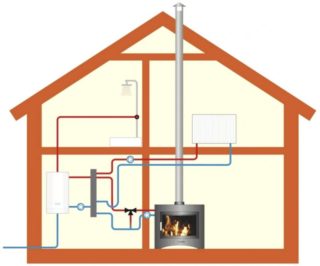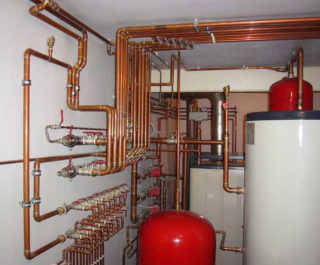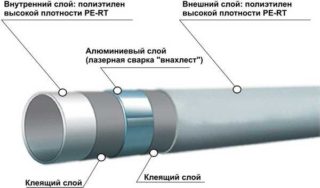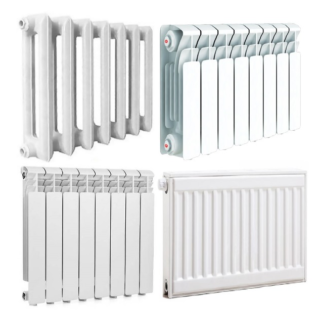You can maintain a comfortable temperature in the living quarters of a country house in various ways. Among the heating devices, the most common are electric and portable wood-burning stoves, as well as infrared appliances and other types of heaters. For capital private buildings intended for permanent residence, all these temporary funds are not suitable. They traditionally equip with water heating. The energy for its functioning is obtained by burning wood, coal or gas. Only in exceptional cases, cheaper electrical resources are used for these purposes.
The principle of autonomous heating
The basis of the water heating system in a private house is a heating boiler, which determines the principle of its action and heating efficiency. Despite the difference in the sources of energy used in it, the essence of the work does not change from this. It consists of the following sequence of transformations:
- When burning fuel loaded into the boiler in a special unit called a heat exchanger, excess heat is generated.
- Due to direct contact of its walls with the tubes laid in them, they are heated to high temperature.
- Since the coolant circulates in these channels (in this case, water) - it warms up to the state of boiling water.
- Next, the hot carrier enters the heating system, which is an extensive network of pipe lines and batteries.
Due to the same heat transfer effect, heating elements heat the surrounding space to comfortable temperatures. Reliability and efficiency of the functioning of the autonomous heating system with water largely depends on the design features of the boiler. Therefore, you will need to familiarize yourself with the known varieties of these systems and learn how to choose a model that is optimal for the given goals. In this case, the need to heat utility rooms (garage, for example) is necessarily taken into account.
Varieties of water heating systems
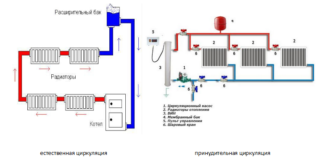 Heating systems mounted in a private house are distinguished by the selected pipe layout, taking into account the layout of the premises and the installation site of the equipment. In addition, before its arrangement, the method of circulation of the coolant is selected:
Heating systems mounted in a private house are distinguished by the selected pipe layout, taking into account the layout of the premises and the installation site of the equipment. In addition, before its arrangement, the method of circulation of the coolant is selected:
- The natural movement of the carrier due to the pressure difference and its own weight.
- Forced method, organized by a pump of one class or another.
- A combined approach that combines the advantages of both.
Before choosing the appropriate option, the type of combustible material that is used as the energy source in the boiler is taken into account. What is more suitable for the specific living conditions of the user: gas, coal, firewood, pellets or electricity - only he decides.
Pipe selection
Separately, the issue of the types of pipes used in the arrangement of the heating system in private houses is considered. Since each of the materials used has its pros and cons, it is advisable to figure out which one is more preferable.
Metal (steel and copper) pipes
Arrangement of water heating with steel pipes will cost the owner not too expensive, which is considered an indisputable advantage of the proposed choice. However, the known disadvantage of this material is easily susceptible to corrosion.Another thing is copper analogues, which have many advantages, including resistance to the damaging effects of the environment and durability.
However, this attractive material has one significant drawback - the high cost of copper pipes, which not every user will decide to purchase. Therefore, in the situation with metal highways, the final decision remains with the landlord.
Polymer (polypropylene) pipe products
The main advantage of polypropylene pipes is their resistance to external influences, which manifest themselves in the form of corrosion and chemical destruction. In addition, they are appreciated for their ease and ease of installation.
The use of pipe products of this class allows saving on fuel consumption (it doesn’t matter whether it is gas or electricity). This is explained by a low coefficient of friction against the walls, which allows to increase the speed of circular movement of the coolant, as a result of which the heat is dissipated exclusively in the batteries alone.
The advantages of polypropylene pipes also include the permissibility of using arbitrary types of heating systems - closed or open.
Metal-plastic pipe blanks
Among the advantages of metal-plastic pipes include all the advantages inherent in their polypropylene counterparts. At the same time, the ability to “hold” very high temperatures and good flexibility (ductility) are particularly distinguished. The latter circumstance allows us to use them in systems such as "warm floor".
A relative disadvantage of metal-plastic products is the high cost, significantly exceeding the same indicator for polypropylene samples.
The choice of radiators
When designing the piping layout of pipelines, special attention is paid to the selection of radiators that can heat rooms with maximum efficiency. Moreover, the general selection procedure suggests taking into account the assortment of products that differ in their forms used in the manufacture of the material.
Most users prefer inexpensive and reliable aluminum radiators, resistant to corrosion and easy to connect. Much less often, they choose the option of combined heating structures consisting of two metals (aluminum and steel).
As for the size and shape of the selected heating elements - here, each user acts at their discretion and taking into account specific installation conditions.
Heating schemes
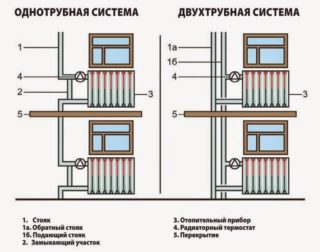 Regardless of what type of energy source the user has chosen, the following basic schemes are allowed for use when arranging heating in a private house:
Regardless of what type of energy source the user has chosen, the following basic schemes are allowed for use when arranging heating in a private house:
- single-pipe wiring of the water main (another name - “Leningradka”);
- two-pipe shoulder system (otherwise it is called a "dead end");
- using a pump (collector circuit).
One-pipe lines, like all other types of wiring, according to the requirements of the standards, are made airtight. In this case, the optimum level is considered to be a water pressure of 0.5-3.0 bar, depending on the temperature.
In two-story mansions, a combined approach is possible that combines two solutions at once. As an example, the following option is considered: on the 1st floor, the user will need to make a collector system, and on the second - to mount the usual wiring with the associated movement of the coolant.
Independent or natural wiring with pre-equipped vertical risers is able to work in the following modes:
- gravity circulation;
- using a bypass mounted pump.
Leningradka and the two-pipe dead-end pipelines do without a circulation pump, and the heat carrier flows in them due to the convective flow of water.
DIY water heating installation
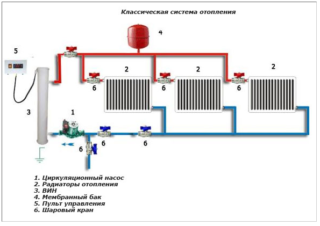 Before deciding to install the system yourself, it is important to consider the following:
Before deciding to install the system yourself, it is important to consider the following:
- Since work on arranging water heating directly affects the entire house and its utilities, it is advisable to combine these measures with a major overhaul.
- If you plan to install the boiler on the floor, a separate room is required for its installation.
- The place for the boiler room is selected taking into account the requirements of current standards - it is well heated and has effective ventilation.
The generally accepted procedure for installing a heating system, as well as its connection to boiler equipment, takes into account many related factors that require separate consideration.
